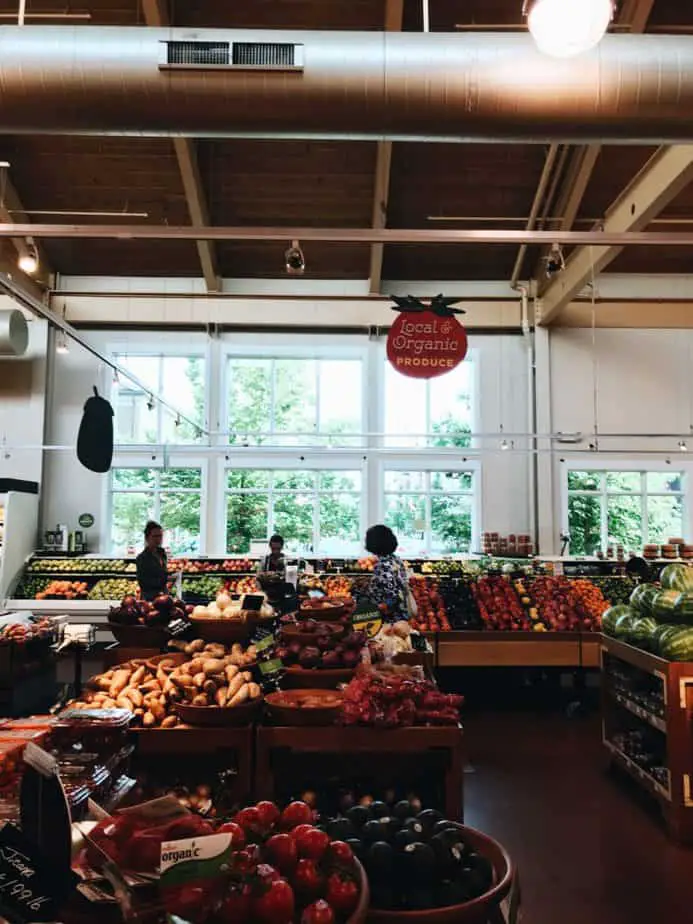Visiting a grocery store or supermarket can be more exciting than you think. The more often we go (sometimes two times per week), the less we wonder why the products are displayed the way they are, and so, we refrain from realizing how incredibly these stores work. If you ever wondered where it’s more common to find produce in a grocery store and then questioned “why”, this article is right for you!

Where you can find Produce in Grocery Store?
Not very surprisingly, produce is most likely to be found at the front section in every grocery store. The reason why this happens can be linked to different reasons, like tradition, convenience, and attraction. You are about to get introduced to these reasons along with the best places to buy produce in the U.S.
Reason for why produce placed there:
Reason 1. Tradition
Ever since the concept of a grocery existed, produce was the first thing that a customer could see when visiting the place. Unlike today, when electricity and refrigeration allow produce to stay in the store for a couple of days, the products sold by a farmer would only last for a day and so he would have had to transport the products to the store where they were sold daily.
This process, besides exhausting and repetitive for farmers, was also hard for stores owners and workers, who were supposed to receive the products and arrange them. Back then, best way to get rid of the produce every day was to leave it at the front of the store or even outside. This way, no effort was wasted in moving box after box to the inside of the store.
Reason 2. Convenience
Another reason for keeping produce at the front section in supermarkets is convenience, but we’re talking about two types of convenience: for customers and the stores.
1. Convenience for customers
Most customers visit the supermarket weekly to buy multiple produce items in comparison to other product categories. It’s all part of personal routines. If customers can’t find what they usually shop for, they’ll probably leave to visit another store. Thus, by keeping the produce at the front, customers can see it first and decide whether to continue shopping there or not.
2. Convenience for the store
Produce, along with poultry and frozen meat or seafood, need their own staging area, and to be near water and electrical outlets to be kept fresh, but also, near the storage, so the products can be replenished easier during the day.
Since storage and power gateways are closer to the walls of the store, produce is placed in its own section near the entrance (following the idea of convenience for customers).
Reason 3. Attraction
The colors and forms of fresh fruits and vegetables are undoubtedly appealing and by keeping them at the front, your store will definitely get the attention of customers. However, this can be the other way around. If the products you display are not very attractive, people will rather prefer not to enter.
Nowadays, supermarkets have multiple floors and entrances. Produce is no longer the only section displayed at the entrance to catch customers’ attention. Some supermarkets keep a working bakery near the entrance or a flower shop. In both cases, the smell of freshly baked bread or aromatic flowers provides a welcoming feeling.
Best Stores to Buy Produce & Prices
Variety and quality are determinants when it comes to choosing the best places to buy produce, besides price, of course. Grocery stores with renowned produce quality and variety are Wegmans, Heinen´s, New Seasons Market, Central Market, and Gelson’s.
Prices at stores:
In matters of price, here’s the price comparison of these highly-rated stores:
- 1lb of banana – $0.49 at Wegmans / $0.59 at Heinen’s / $0.99 at New Seasons Market / $0.48 at Central Market / $0.99 at Gelson’s.
- 1lb of organic honeycrisp apple – $4.29 at Wegmans / $3.99 at Heinen’s / $4.59 at New Seasons Market / $3.99 at Central Market / $4.99 at Gelson’s.
- 1 container of strawberries – $6.99 at Wegmans (32 oz) / $4.99 at Heinen’s (12 oz) / $9.29 at New Seasons Market (1lb) / $4.97 at Central Market (1lb) / $7.99 at Gelson’s (1lb).
- 1 lb of broccoli crowns – $1.99 at Wegmans / $1.99 at Heinen’s / $4.09 at New Seasons Market / $1.75 at Central Market / $5.99 at Gelson’s.
- Organic bunch of carrots – $2.49 at Wegmans / $1.99 at Heinen’s / $2.59 at New Seasons Market / $1.28 at Central Market / $2.99 at Gelson’s.
Comparison between the sellers:
As you can see, the average prices at Central Market are cheaper, while New Seasons Market and Gelson’s are more expensive stores to buy produce. These are great facts to consider when buying fresh vegetables and fruits within a budget.
Also, you should know that Wegmans, Heinen’s, and Central Market offer delivery and curbside pick-up for your groceries. You can access this service through their websites. Meanwhile, New Seasons Market and Gelson’s enable you to shop online through Instacart.
Conclusion
As you see, there is more than one reason why grocery stores keep on displaying produce at the front section. In sum, produce products are more appealing to the sight and they invite customers to enter and shop at a supermarket. Traditionally, this is the way it has worked for decades, and it’s still the most convenient option for stores. Multiple stores in the country sell outstanding produce items like Wegmans and Central Market, which is relatively cheaper than other stores.
Frequently Asked Questions
How can I join Instacart?
Through browser by accessing instacart.com, then click on “sign up”. Or you can download the app at the Apple Store or Google Play.
Is it common to see the three sections (produce, flower shop, and bakery) together?
More than you would think. Some stores put them all together at the entrance so your senses can be captivated instantly and more quickly.

